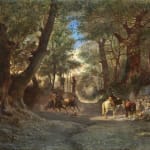Carel Max Gerlach Antoon QUAEDVLIEG
Further images
This fine painting, oil on board, is painted in the typical miniature style of the Dutch artist Carel Max Quaedvlieg, a technique in which he excelled.
The painting depicts a scene set in the surroundings of Rome, probably in the Castelli Romani: in a forest of oak and chestnut trees crossed by a path, a peasant on horseback is leading two other horses with baskets on their backs.
He is heading towards a fountain where other two other peasants are resting.
A joyful little dog, typical of Quaedvlieg’s subjects, welcomes the newcomers.
Carl (Karel) Max Gerlach Antoon Quaedvlieg was born in Limburg and enrolled at the Academy of Fine Arts in Antwerp and in Düsseldorf. Following his wife Marie-Thérese Eymael's death, however, he decided to move to Rome in 1853, then aged thirty, and ended up spending the rest of his life in the city.
Soon finding his place in the city's artistic life, he took up residence at 42, Via Margutta and devoted his energies to studying the great masters, subsequently transferring the lessons learned through direct contact with the masterpieces of the past into his own work. His subjects of choice varied from scenes of daily life to views of the Roman countryside, and even included far more unusual themes such as the carnival.
He showed his work for the first time three years later, at the annual exhibition held by the Società degli Amatori e Cultori delle Belle Arti in its historic venue in Piazza del Popolo, entering three paintings: an animalier theme and two views of the countryside around Rome, the celebrated Ager Romanus.
He was to afford priority to such themes throughout his artistic career, in the course of which he received many accolades – he was made a member of the Pontifical Order of St. Gregory the Great and his Apostle Paul and the Prophetess Eudora was to be displayed in the Pantheon – enjoying popularity not only with collectors but also with eminent members of society. One has but to consider that his illustrious patrons included Princess Marianne, the sister of King William II of the Netherlands.
While the painter's favourite subject was the Roman countryside, we should not overlook certain fairly large oil paintings depicting carnival scenes on the city's Corso, remarkable for their teeming compositions and for the care lavished on the figures' features. Such works are of eminent collecting interest.
JOIN OUR MAILING LIST
Subscribe to our mailing list in order to receive news on new acquisitions, exhibitions, special previews and more!
* denotes required fields
We will process the personal data you have supplied to communicate with you in accordance with our Privacy Policy. You can unsubscribe or change your preferences at any time by clicking the link in our emails.

